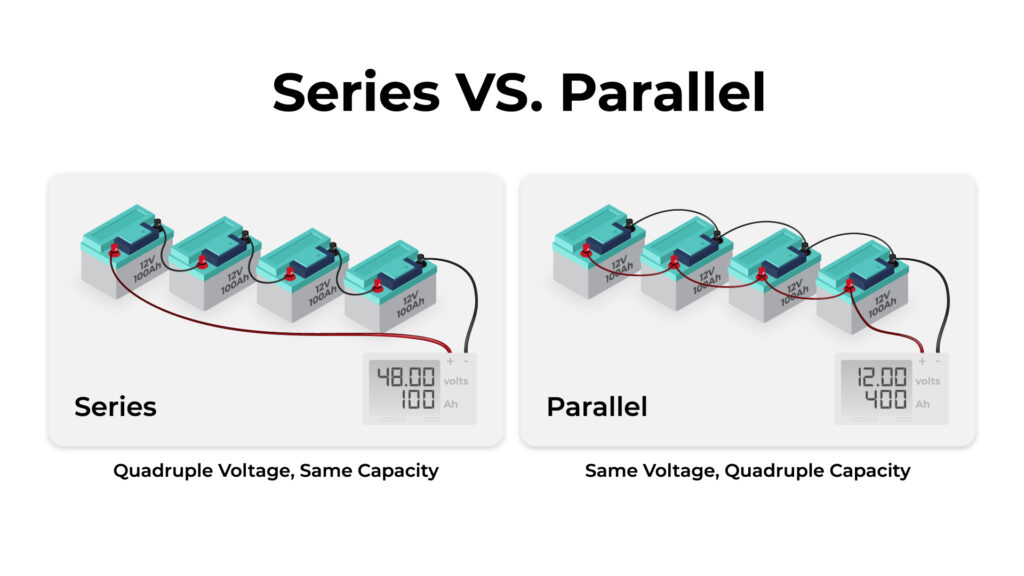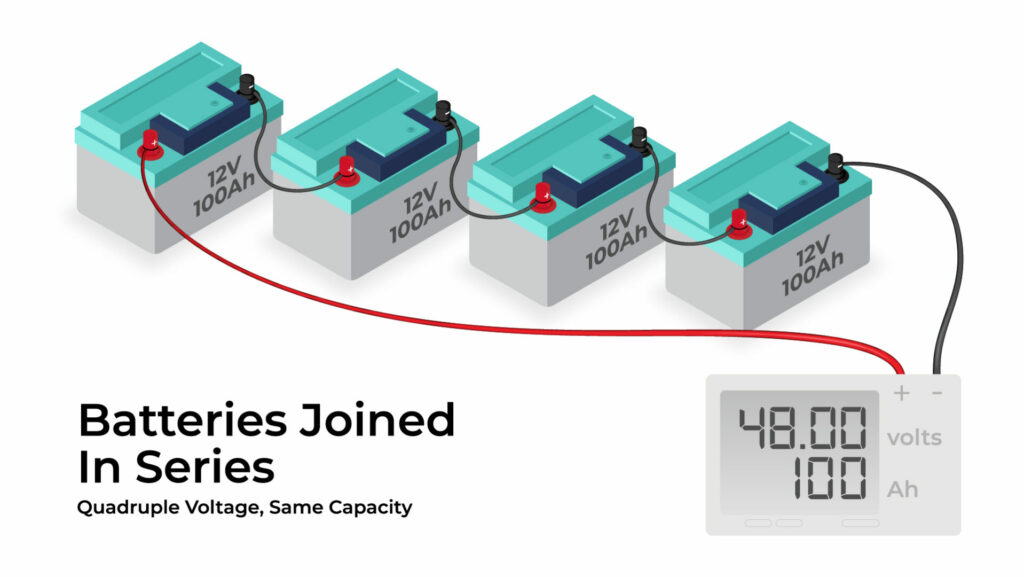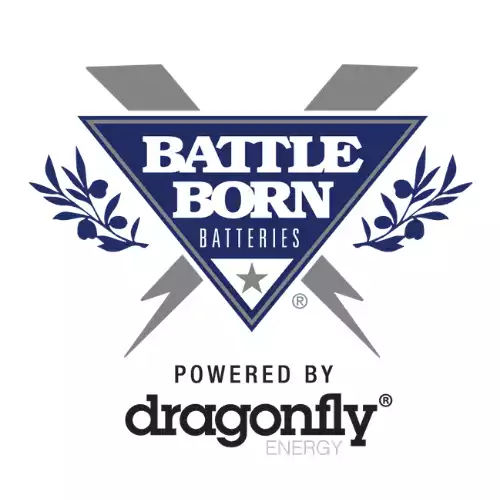Table of Contents Show
A bank of batteries is a group of two or more RV batteries that are connected using either series or parallel wiring. This allows you to store more power than would be possible with a single battery, and to increase amperage, voltage, or both.
There is always a little confusion around this topic so today we are going to try and explain what you need to know about wiring RV batteries in series vs parallel.
What is the Difference Between Batteries in Series vs. Parallel?

When wiring batteries in series, it increases the overall voltage, but not the capacity (amp-hours) of the batteries. For example, two 12V batteries rated at 100 amp hours wired together in series equals 24V of power in total but remains a capacity of 100 amp-hours.
When wiring batteries in parallel, it increases the overall capacity, but not the voltage of the batteries. In this example, two 12V batteries rated at 100 amp hours wired together in parallel still equals 12V of power but increases the capacity to 200 amp-hours.
Whether wiring RV batteries in series or in parallel, it is best to use batteries of the same voltage and capacity (even brand if possible). It is also a good idea to make the wires that connect one battery to another all as close to the same length as is reasonable.
How to Wire Batteries in Series

For application in an RV, you are generally only going to wire batteries in a series when you are using 6V batteries. Remember, wiring batteries in a series increases the voltage. The typical RV is made to handle 12V.
Pro Tip: Not sure which battery voltage you need? Read our article 12 Volt Or 6 Volt RV Battery: Which Is Better?
So if you are wiring two 6V batteries in series, you will simply connect the positive terminal of one battery to the negative terminal of the other. This will give you the 12V of power that most RVs need.
After wiring the two 6V batteries together in series, connect the RV positive cable to the open positive terminal on one 6V battery and connect the RV negative cable to the open negative terminal on the other 6V battery.
When wiring in series, you never want to connect the RV positive and negative cables to one single battery. Connecting the RV’s load wires (positive and negative cables) to separate batteries will keep the set-up balanced and help the batteries last longer.
If you want to use 6V batteries to also increase your capacity further, you can then connect each series pairing together in parallel so that you don’t increase the voltage to more than 12V. This is called a series-parallel connection, which we will discuss in just a minute.
How to Wire Batteries in Parallel

To wire two 12V RV batteries in parallel, you would simply connect the two negative terminals to each other and then connect the two positive terminals. This will keep your voltage at 12V (which is ideal for your RV) but double your capacity, meaning you will have battery power for longer before you need to recharge.
Though all of your terminals now have wires connecting the two batteries together, that’s okay. You can attach more than one wire to each terminal. That’s how this works.
To connect your two 12V batteries that are now wired together in parallel to your RV, you simply connect the RV positive cable to the positive terminal of one 12V battery and connect the RV negative cable to the negative terminal of the other 12V battery.
Similar to connecting to two batteries wired in series, you don’t want to connect the RV’s load wires to a single battery. Separating the connections to two different batteries helps keep the setup balanced and extends the life of the batteries.
Differences in Charging Batteries
There isn’t much of a difference in charging batteries in series vs parallel than there is charging a single battery. The basic idea is the same.
With a single battery, you would attach the positive output of the battery charger to the positive terminal of the battery. You would then attach the negative output of the battery charger to the negative terminal of the battery.
As long as you have appropriately wired your battery banks, the idea is the same. On a single battery, the positive load wire from the RV is attached to the positive terminal of the battery, and the negative load wire to the negative terminal.
Whether you are charging a series of two 6V batteries or charging two 12V batteries (or more) in parallel, you would attach the positive output of the charger to the positive terminal where the positive RV load wire is attached. You would also attach the negative output of the charger to the negative terminal where the negative RV load wire is attached. This helps ensure that the batteries in the bank charge at an even rate.
Be sure that your charger is rated to the same voltage as the bank you are charging. A 12V charger can charge a 12V series bank or 12V parallel bank. But if you have a special case where you are wiring in series to 24V, 48V, or some other voltage, you’ll want to be sure that your charger matches the voltage.
You can also charge individual batteries within a bank with a charger that matches that battery and charge them one by one. For instance, if you have four 12V batteries strung together in series, but only a single 12V charger, you can connect and charge each individual battery one by one.
Another thing you want to make sure of is that your charger is rated for the battery chemistry that you are charging. Most deep cycle batteries have similar charging profiles but lithium batteries require a slightly different voltage.
Battle Born Batteries offers a full line of lithium-ion batteries. Whether you simply want a drop-in replacement for your current battery or want a reliable off-grid system for some serious boondocking, they have you covered. We've used and abused our Battle Born Batteries for years and can confidently say lead is dead.
Tapping into a Series String
There is the possibility that you might want to wire a battery bank (string) in series in order to increase voltage for special applications. Perhaps you have a large solar array and want to power an inverter that can, in turn, power 120V appliances from battery power.
In that case, you might choose to string some 12V batteries together to reach a higher voltage like 24V. If you are still operating a 12V system in your RV for things like house lights, control panels, etc., you need to use a DC-DC converter.
In an emergency, you can attach the RV 12V load wires to the positive and negative terminals of a single 12V battery in the series to power your RV’s 12V system. This will unbalance the series, cause it to be less efficient, and possibly lessen its lifespan.
Series and Parallel Connection

Remember when we said that you could actually string more than two 6 volt batteries together but still maintain their compatibility with your RV’s 12V system? Okay, here’s how you do that.
You already know how to wire two 6V batteries in series. Simply connect the positive terminal on one battery to the negative terminal on the other. Now you effectively have a 12V battery bank.
But if you want to use 6V batteries to further increase your capacity, you can do that by wiring a 6V battery series pair to another 6V battery series pair (or multiple pairs) by connecting those pairs in parallel.
Once you have your 6V pairings created, simply connect them in parallel by connecting the open positive terminal of one pair to the open positive terminal of another pair, and do the same with the open negative terminals, connecting the open negative terminal to the open negative terminal.
Then from one end of the string of batteries, connect the RV’s positive load wire to the positive terminal of the battery. From the opposite end of the string of batteries, connect the RV’s negative load wire to the negative terminal of the battery. Remember it is okay that the RV load wires are connected to a terminal that is already wired together to the terminal of another battery.
Safety Devices in Series and Parallel Connection
The key safety device in a series or parallel connection is the wire used to connect them. That’s a very important consideration not just for efficiency, but safety. Make sure that it is rated for the amperage that will pass through it.
Another safety device when wiring RV batteries in series is the charger in your RV’s converter. This is especially important if your RV is going to be plugged in most of the time. Some older chargers may be such that your batteries can get overcharged, which can damage them. You want to be sure that your RV converter has a smart or 3-stage charger that allows for safer charging.
Also, be sure to do regular battery maintenance. Keep the terminals clean, and if you have flooded lead-acid batteries, you’ll want to be sure and check the water levels in them. LiFePO4 or Lithium batteries do not have any regular maintenance.








Parallel.
Hi Jason,
I have a 2018 Dutchman Kodiak, Travel trailer 23’ in length. I have two 6 volt Trojan batteries wired in series with 2 gauge wire fused and cut off switch, I also have a renogy 2000 watt inverter with 2 stand alone renogy solar panels monocrystalline, also in series with 10 gauge wire with a 200 amp fuse and cut off switch between the batteries and the 30 amp renogy controller and another 30 amp fuse between the panels. I fabricated a bracket to set in the back of my truck so on travel day it will run my 6 cu ft refrigerators, a small 3 cu ft freezer inside my trailer and a 2 cu ft small refrigerator in my storage area. It does a great job of keeping everything running. So 3 days before we travel we load everything in the refrigerators and freezer while running on 120 voltage, two days before travel load out the rest of the trailer with food, clothes, and whatever we are going to need for the trip, but we have stopped loading too much food and a small amount of drinking water, we go to Sams club for that. We find that lightens our load out and we’re not as heavy , also helps on the fuel consumption. The only place we Boondock is at Magnolia beach, TX and our system is just the right amount to run everything except our A/C so we use a 4500 Onan generator for that, and also on cloudy days. We usually stay at military bases with full hook up or state parks with electric and water and a dump station. We will be going to Blue Angel in Pensacola Fl. On December the 15th for a month then probably back to Corpus Christi, TX for another month then go back home or maybe longer all depends on on my allergies cold weather. Thanks again for all y’all’s videos and updates.
Bennie and Kyong